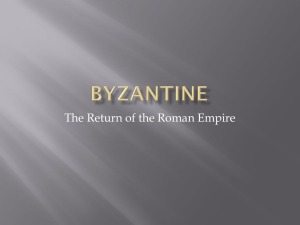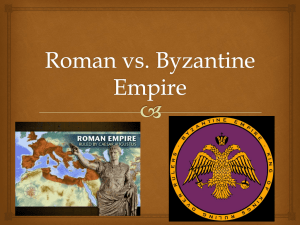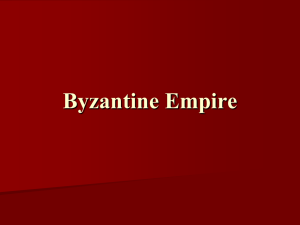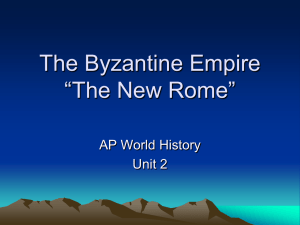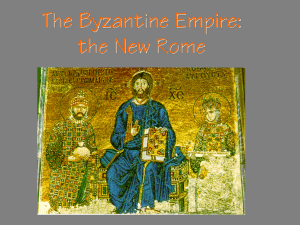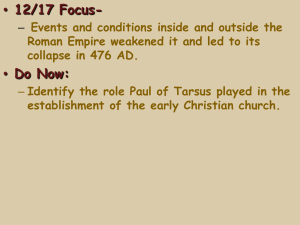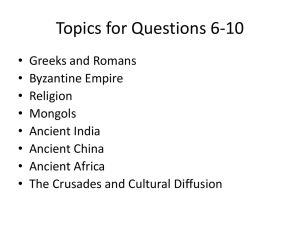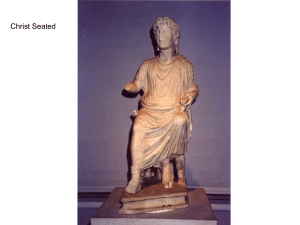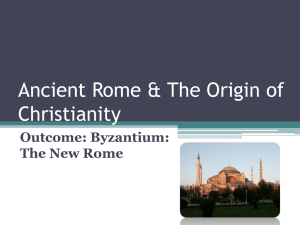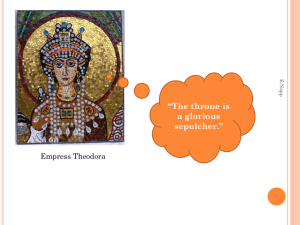European Christendom 500-1300
advertisement
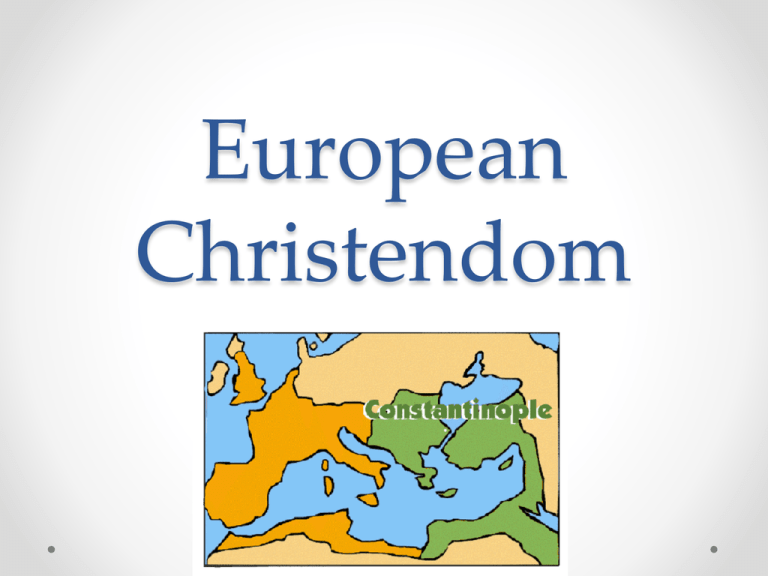
European Christendom 500-1300 Ms. Jerome Emperor Diocletian • Vast empire as ungovernable • Split the Roman Empire in half • Created two equal emperors to rule under the title of Augustus. • Created the Western Roman Empire and the Eastern Roman Empire. Persecution of Christians under Diocletian 284-305 Constantine • http://www.youtube.com/watch?v=GlnJRyZTfEo&fe ature=related • Under Constantine, the Christians are the favored group in the empire • Becomes Augustus in the West • Signs the Edict of Milan, together with Augustus in the east, Licinus o Edict offers tolerance to the Christians Constantine—Sole Ruler • Licinus later returned to persecutions • Defeated by Constantine at the Battle of Adrianople • Constantine becomes sole ruler of entire Roman Empire • Rome in the west was in decay • Constantine created a new center in the east Byzantium • Constantine founded the Constantinople, the cite of the old Greek city Byzantium Byzantium • Mediterranean and Black seas connected through the Bosporus Strait • As the West collapsed the East prospered • The Byzantine Empire was the heir to the Roman Empire Center of Trade • Geographic location made Constantinople center of trade, linking Asia with Mediterranean • Became a rich and powerful city • Peaked under rule of Justinian The Old Rome—the three siblings of Rome • The Old Roman Empire was under three influences by 700 o The west: Political disintegration –the Medieval story (Feudal Pumpkin) o Eastern Roman Empire –wielded authority over the Balkans, Asia, Middle East, Egypt (Byzantine Empire) o South: a new power—Islam • Would become the greatest of the three civilizations Byzantine Culture • • • • • Mostly Greek culture Always considered themselves Roman Completely disregarded Latin Grew to have little regard for the Pope Read a Greek Bible in the east Byzantium • Took religion form Christianity • Took its culture form the Greeks • Governmental structures were largely Roman Justinian (527-565) • The last of the Roman emperors • Driven to revive the old Roman Empire by recovering lost Western provinces • Co-ruled with his wife Theodora • Together, they had three major accomplishments 1. Construction of Hagia Sophia • One of Byzantium’s foremost works of art • Gold, silver, ivory and dazzling mosaics in the interior 2. Corpus Juris Civilis • The “body of civil law” • Served as the basis of law in Western Europe and Byzantium • Law code favored autocratic law over popular sovereignty • Absolute rulers found much to admire in Justinian’s precept that “the emperor’s decree should be the unquestioned law” 3. Resurgence of Imperial Rome • Wanted to relive “imperial Rome” • Attempted to recover all of the lost provinces in the West • For a short time, Justinian succeeded in bringing almost all of the Mediterranean coastline under the domination of his “Roman authority” • “For a few glorious years, the Mediterranean was again a Roman sea.” • Campaigns were the “Gothic Wars” o Drained the Roman treasury o Bankrupted the Byzantine Empire o Barbarians would reconquer the land (save the Southern Italian coast) shortly after Justinian’s death Eastern vs. Western Christianity • Byzantine Christians rejected the Pope’s claim to authority over all Christians • Byzantine clergy married • Greek not Latin was the language of the Byzantine Church • The Church divides largely over the issue of icons • In 1054 there was a break and the East no longer recognized the Pope as the church Authority • Byzantine Church—the Eastern or Greek Orthodox • West became: Roman Catholic Church Biblia Pauperum, the "Bible of the Poor” Byzantine Heritage • Although the Byzantine Empire would fall to Ottoman Turks (Muslims) the Ottomans would adopt much of its culture • A blend of Greek science, Christian religion, philosophy, art, literature, engineering, law • Preservation of classics • Culture of Byzantine Empire would later influence the West in what becomes known as the Renaissance.

